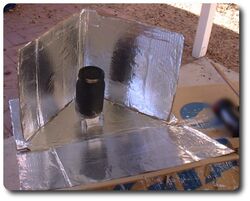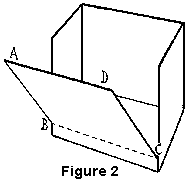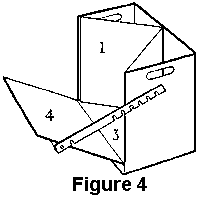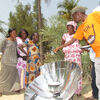- 3 Talk
-
Reflective Open Box
I have been very impressed to read, in SBJ #17, that the solar panel cooker (SPC) idea, as publicized by Barbara Kerr and myself in the preceding issue, had met with an abundant response. Even negative results can be of interest when we seek to understand them. For instance, in the comment, "I used a "turkey -size" oven cooking bag and a dark ceramic teapot. Nothing!", there are two interesting clues. First the ceramic teapot was not a good choice because ceramic can be a bad conductor of heat [depending on its density, Ed.]. Food can remain lukewarm, even if the pot is very hot on the outside. And secondly, a turkey is an enormous bird, and using a bag appropriate to hold it may mean that the quantity of food could have been too big for the cooker.
Let us not forget that the SPC was designed as a substitute for the traditional box for small quantities of food. The dimensions given for my prototype in SBJ #16 are appropriate only when cooking for one person.
During the 1994 summer, I somewhat improved the SPC's convenience and efficiency by introducing two changes: a new system for creating the greenhouse effect and a more compact design.
Undoubtedly, oven bags are unbeatable for their lightness, but in my city (Lyon, 500,000 inhabitants) there are no oven bags available in the supermarkets. On the other hand, Pyrex salad bowls are very easy to find everywhere in France--even in small towns. Their price (about $4 US) is ten times the price on an oven bag, but they can be used hundreds of times for solar cooking as well as for other purposes in the kitchen. For traveling, however, they are relatively heavy and cumbersome.
Salad bowls and oven bags share the following disadvantages: they hamper access to the food, and they retain the moisture coming from the heated food and need periodic drying [see Tips and Tricks, Page 3]. These drawbacks can be avoided if we put only the lower part of the cooking pot inside of a glazing (figure 1), instead of the whole pot with its lid.This can be done by placing the dark pot into a glass dish whose diameter is slightly larger than that of the pot.
Obviously the advantages of such a system are partially offset by extra heat loss from the uninsulated lid. By raising the pot off the ground a further gain is achieved. In fact, my experiments have shown that cooking times with this new system are no longer than with the original design with a salad bowl up-turned over the pot.
In order to improve stability, I reduced the number of panels from five to four. A pleasant surprise was that the removal of the central back panel not only resulted in a more compact and stable cooker, but also improved the efficiency of the reflective surfaces, by permitting multiple reflections between the two remaining vertical panels. This peculiar assembly I propose to call a "reflective open box" (ROB) to distinguish it from the original solar panel cooker (SPC).
Construction Edit
Edit
I have made it and it is fun.To make an ROB, start with a rectangular, rather tall, cardboard box (see below for dimensions). On one of the broader sides, draw a horizontal line (BC) about two inches above the bottom (figure 2) and cut the seams along AB (stop at B) and DC (stop at C). Fold down the front panel ABCD using BC as a hinge. Stack a few rectangular pieces of cardboard in the bottom of the box, to raise the floor level up to the level of BC.
Cut and fold another piece of cardboard so that it can be inserted into the box to form panels 1 and 2 in figure 3. The angle formed by these panels is adjustable at time of construction. Smaller angles concentrate the sun more, but require more frequent adjustment to follow the sun. A good compromise seems to be any angle between 60 and 90 degrees. Cover this piece with aluminum foil and glue or staple it in place. Apply aluminum foil to panels 3 and 4 as well.
The ROB shown in the photograph has the following over-all dimensions: Length: 46 cm (18"), Width: 32 cm (12.5"), and height: 42 cm (16.5"). These dimensions correspond to a reflective area of about 5,000 sq. cm. (770 sq. in.) which proved sufficient to cook for two persons.
A wooden prop can be used to adjust the front panel (figure 4). The single notch near panel 4 is used to lock this panel in a closed position for storage. Rocks can be placed in the triangular chambers behind panels 1 and 2 to stabilize the cooker in the wind.
In summary, the ROB seems to be a more convenient and efficient design that could replace the original SPC for regular home cooking. Of course, the latter equipped with an oven bag remains a better design if a light-weight, foldable cooker is needed.
Plans in other languages Edit
Edit
External links Edit
Edit

There are also plans for making this cooker in a way that it is collapsible.  Added by Matt Sponheim
Added by Matt Sponheim


















